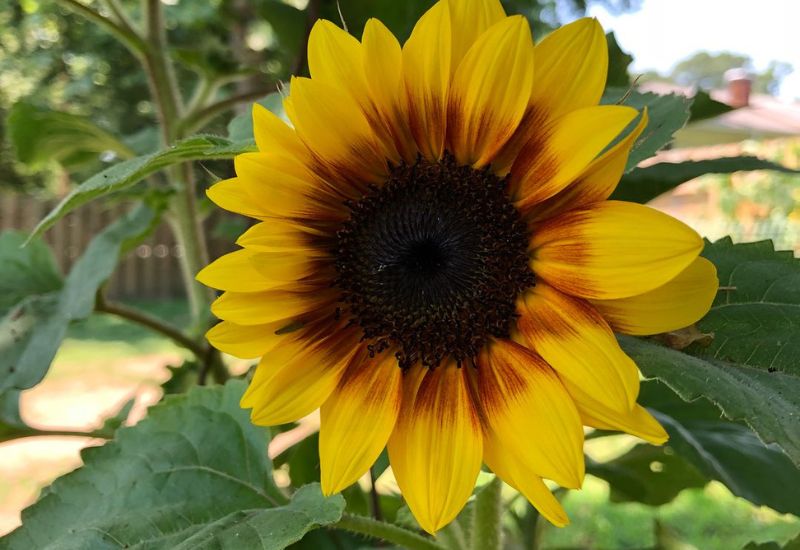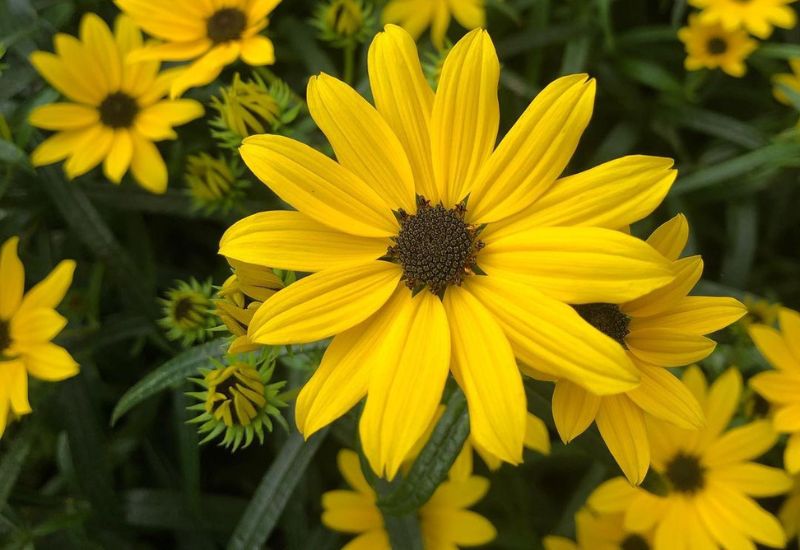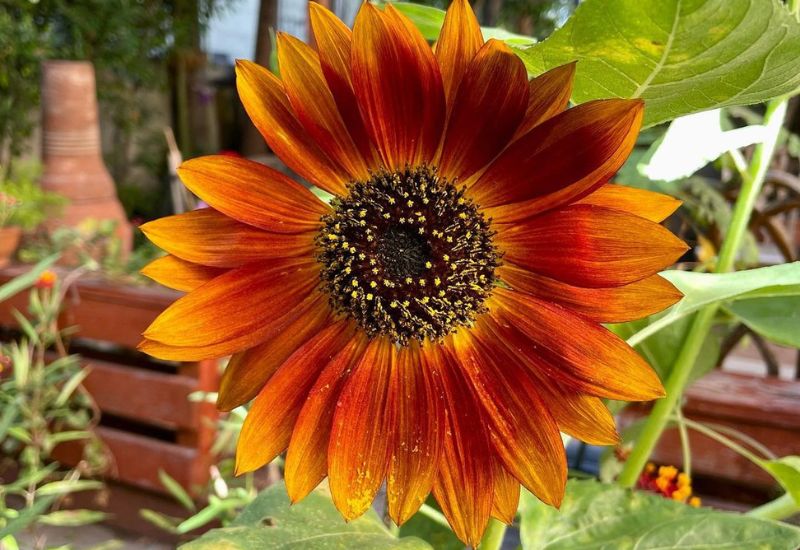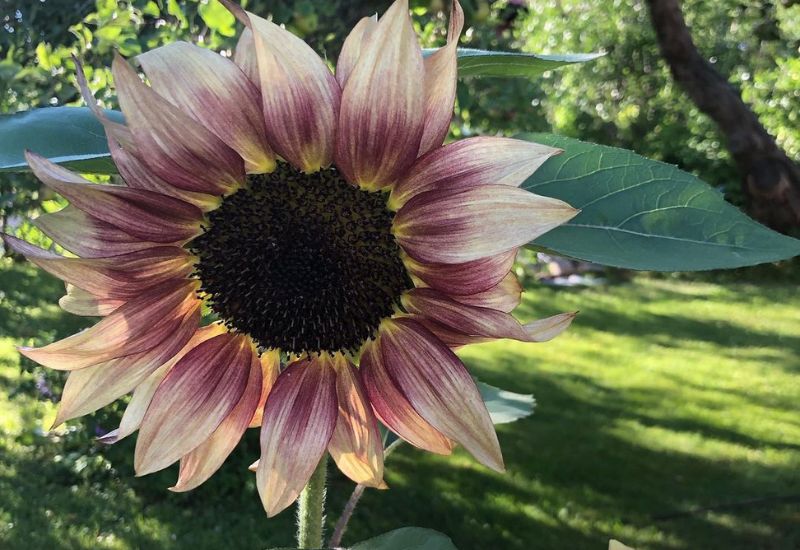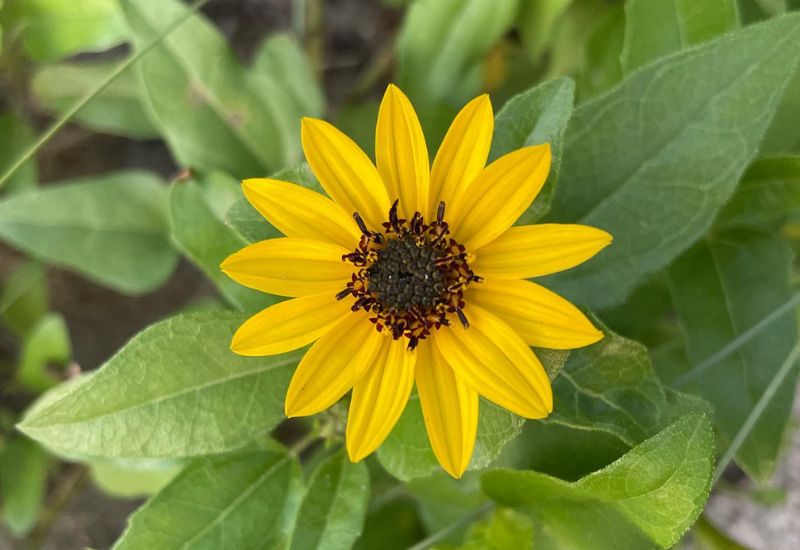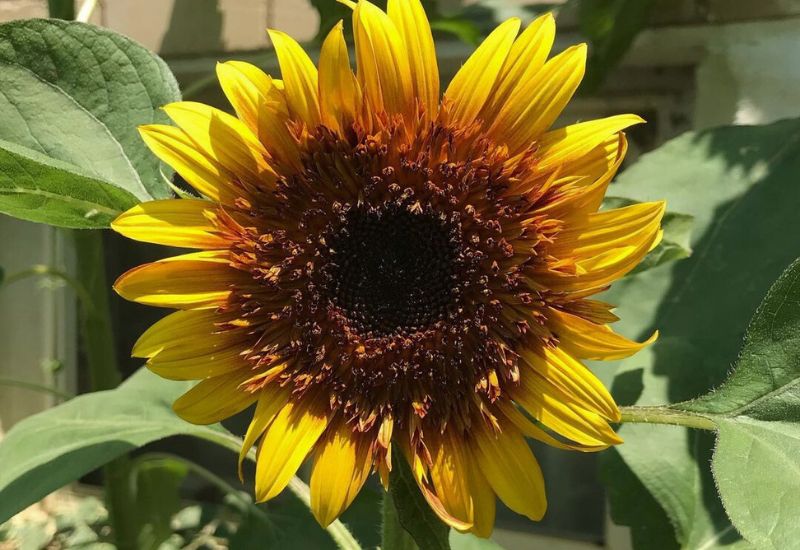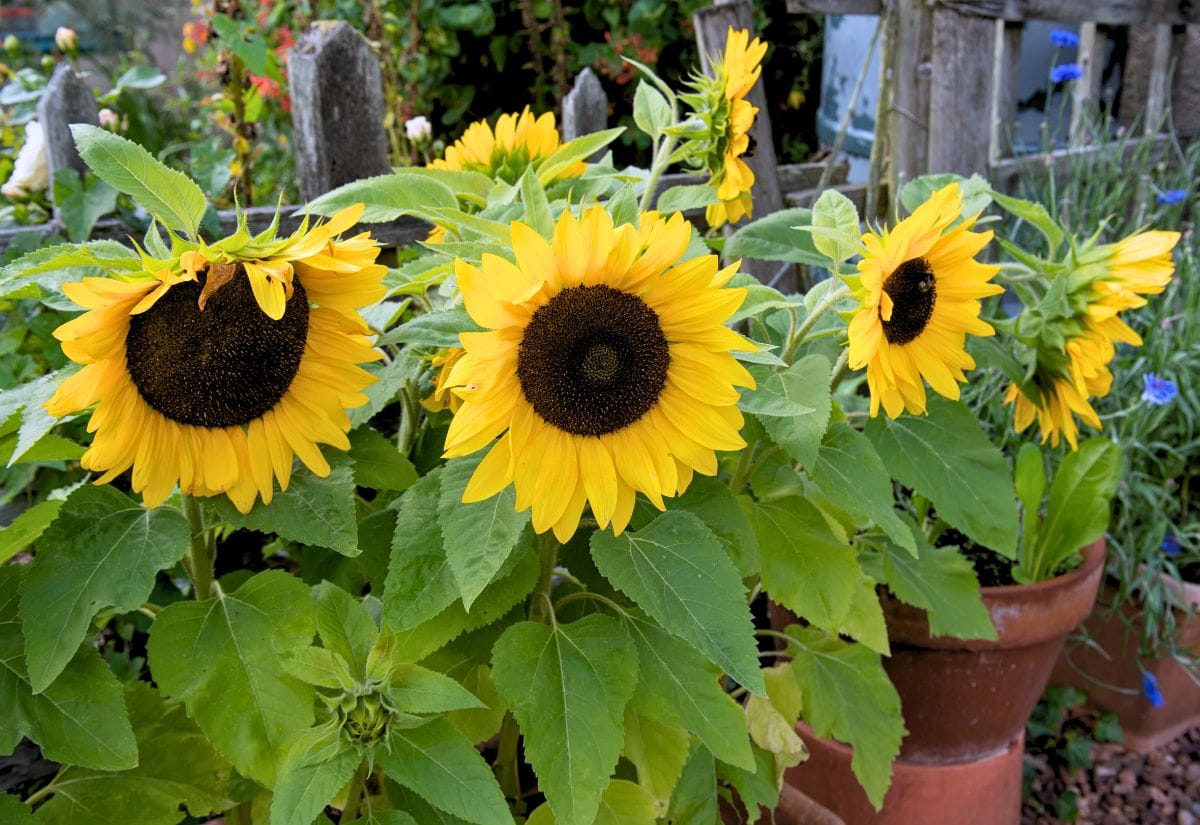
The massive, energetic blooms of sunflowers that tower like giants in open fields and large gardens are a real spectacle! But how about if you only have a small yard or even a terrace? Or how about if You want a variety for a low border or bed? Then you are in luck, because there are dwarf cultivars and even some small natural species, and they are as striking and as colorful as their bigger sisters!
Called “sunflower” because its large blossom, actually an inflorescence, follows the Sun during the day, the genus Helianthus, and especially its annual species, H. annuus, is a very decorative garden plant, but also used for food.
But it also offers us a great range and sizes! The tallest can reach 13 feet (4.0 meters) into the sky, but the smallest classic, allegedly the cultivar ‘Elf’ is only 16 inches (40 cm) in height. However, perennial willow leaved sunflower (Helianthus salicifolius) ‘Low Down’ only reaches 12 inches (30 cm)!
So, get ready for a sunlit journey in the unusual world of short and small sunflower varieties, because there are quite a few that you could easily grow even in a modest sized container! And they are not all yellow…
12 Dwarf but Eye Catching Sunflower Varieties
These are really small sunflower varieties, none of them grows more than 3 feet tall (30 cm). But their blossoms can be quite big, and they come in all warm colors!
And we want to start with a joyous note, with a dwarf variety that will bring a smile on your face in the hot and sunny days of summer…
1. ‘Happy Days’ Sunflower (Heliopsis Helianthoides ‘Happy Days’)
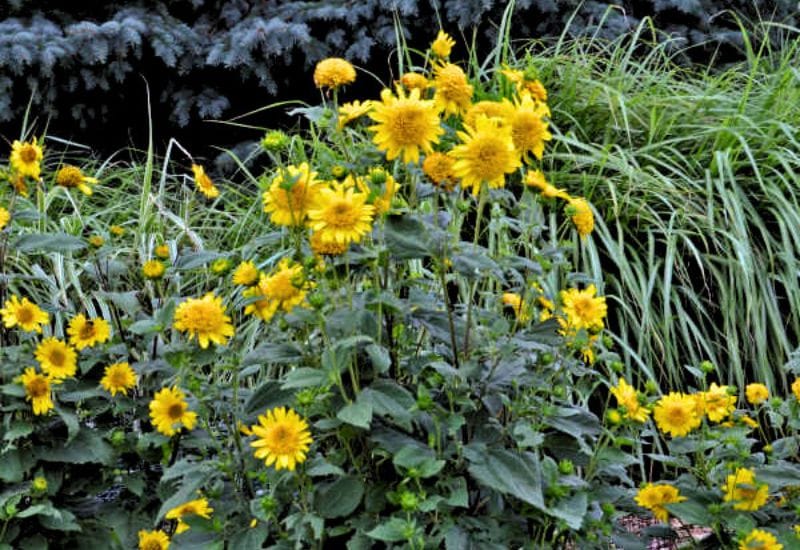
We can start with a good humored cultivar of Helianthus helianthoides with a cheerful name: ‘Happy Days’ sunflower. This is a popular perennial variety that only reaches 28 inches tall (70 cm), but it is also a clump forming herbaceous plant, so it spreads out as much as well.
And this means many flower heads, even if not as massive as those of its famous relatives… In fact, each blossom is 4 inches across (10 cm), not colossal, but still quite showy… And they also have a special quality… They are fully double and they are anemone shaped. In fact, the ray petals are quite long, with soft tips, but the disk blossoms, which are usually almost invisible, grow petaloids (small petals) that give you a soft and fluffy center.
All this comes in the classic golden yellow of this genus, but also for a very long time, from mid summer to fall! It will also form a dense clump of foliage with an herbaceous and rough texture. And it is also a winner of the prestigious Award of Garden Merit by the Royal Horticultural Society.
An energetic dwarf variety, ‘Happy Days’ could work well in small perennial borders in informal spaces, or as a cut flowers, and it would be excellent in a cottage garden to add some energy and light.
2. ‘Firecracker’ Sunflower (Helianthus annuus ‘Firecracker’)
The annual ‘Firecracker’ cultivar is a close relative of the giant sunflowers we all know and admire, but it will never grow to more than 3 feet tall (90 cm). However, unlike ‘Happy Days’ it has an upright habit, and the inflorescences can be fairly big, between 4 and 6 inches across (10 to 15 cm).
Like its towering sisters, it will attract lots of butterflies, bees and pollinators in the summer months, when it is in bloom… And it will do it thanks to its long and velvety ray petals, which start off with a particularly intense and deep, warm tonality of yellow at the tips, but they darken at the root, forming a halo of a copper to chocolate orange! But the large central disk brings this effect to new heights, with its extremely dark purple, which appears as black to the naked eye.
The leaves will grow at the base and up the stem, and they are typically broad and rough looking, bright green. This variety is also a recipient of the Award of Garden Merit by the Royal Horticultural Society.
Ideal for cut flowers and containers, ‘Firecracker’ sunflower will also add contrast and accent to borders in a sunny and informal garden.
3. ‘Low Down’ Willow Leaved Sunflower (Helianthus salicifolius ‘Low Down’)
I suspect that ‘Low Down’ is indeed the shortest variety of sunflower, and it is a cultivar of of the willow leaved species (Helianthus salicifolius) native to the United States. It is a clump forming perennial which produces lots of small flowers, about 2.5 inches across (6.0 cm) and for a late season display.
In fact, they will start in August and continue into fall. You would be forgiven if you confused them for daisies because they have long and deep but bright golden yellow petals, which look a bit like multi rayed stars… Looking up into the sky, they come generously at the top of the shrubby clump at the base.
The central disk is small, brownish in color, but this does not seem to deter butterflies and even bird that come to feed on its nectar and then seeds. You may have guessed that it also has another unusual characteristic… The leaves are narrow and long, almost needle like, and they provide fine texture with their bright green shade.
‘Low Down’ willow leaved sunflower is the best variety for a rock garden, or to form clumps in perennial beds or border fronts. Cut it back as winter approaches so it will come back in full strength year after year.
4. ‘Little Becka’ Sunflower (Helianthus annuus ‘Little Becka’)
And we come to a particularly warm cultivar of annual sunflowers (Helinathus annuus) called ‘Little Becka’. Rising to 2 to to 3 feet tall maximum (60 to 90 cm), it makes up for what i lacks in height with its very striking blooms… The 5 inch wideheads (12.5 cm), or “capitula” (for technicians) appear in mid summer and they keep going for about two months, in small clusters of about half a dozen at the top of the upright and sturdy stems.
And they are packed with energy! In fact, it is one of the most colorful varieties you will ever find… On the ray petals, you will find intense shades of deep yellow, but also orange, rust and in some cases, vibrant shades of red on the carmine side! These tend to go from brighter at the tips, to darker, to form a brilliant ring on yellowish tonalities at the center…
The effect is then completed by the large disk, which ranges on the purplish to brownish range. The leaves are what you would expect, hard looking and broad, but on a smaller scale compared with her giant sisters.
‘Little Becka’ is the ideal dwarf sunflower variety to bring the energy of summer to flower beds or even short borders with a strong and dramatic effect! It will certainly draw a lot of attention from your visitors, as well as pollinators and birds! P
5. ‘Mrs Mars’ Sunflower (Helianthus annuus ‘Mrs Mars’)
Here is another striking variety of annual sunflower for you: ‘Mrs Mars’… I don’t know if the name is due to its unusual appearance… For sure, it is a dwarf cultivar, only growing to about 2 feet in height (60 cm) it still produces flower heads that reach 5 to 6 inches across (12.5 to 15 cm) during summer and the beginning of fall.
But this cultivar is mainly noted for the original coloring that it displays… Usually starting cream white at the tips, the ray petals then blush to rosy tints that can change, maybe depending on light and soil conditions.
Sometimes, they hit perfect rose, but there are specimen that go quite deep, towards plum depth and even peak on dark reddish shades! The large disk in the middle is quite amazing too, of the darkest violet blue you will ever see, almost black and even glistening in the Sun! A magnet for pollinators and later in birds, like others, it has broad, almost heart shaped leaves to frame its floral display.
One if the most creative and unusually colored varieties of dwarf sunflowers, annual ‘Mrs Mars’ will add an inebriating touch of color with its rosé wine tonalities to your sunny beds, and it is perfect for containers as well.
6. Beach Sunflower (Helianthus debilis)
A totally different but still short, naturally dwarf variety is beach sunflower… That is, when it comes to height… Yes, because it inly grows to a maximum of 2 feet tall (60 cm) but it spreads to 4 feet (120 cm)! Native of southern regions of the USA, this sprawling and creeping perennial is unique, because it likes dunes and sandy beaches, as the name suggests…
The flowers are very traditional looking, like daisies; they are only 3 inches across (7.5 cm) and with 10 to 20 golden yellow ray petals, which are quite broad, elliptical, and a small dark brownish to purplish center. Despite the habit of the plant, they come on short but straight and thin upright stems.
But the exceptional quality of Helinathus debilis is that it is in bloom all the way from spring to fall, and in areas where winters are mild, even all year round! Even the foliage is quite distinctive; the small leaves are irregularly lobed and teethed and of a bright hay to lawn green color!
Unlike other varieties, beach sunflower is ideal as groundcover, and it will work wonderfully well in slopes and sandy dunes, even by the seaside and in coastal gardens!
7. ‘Teddy Bear’ Sunflower (Helianthus annuus ‘Teddy Bear’)
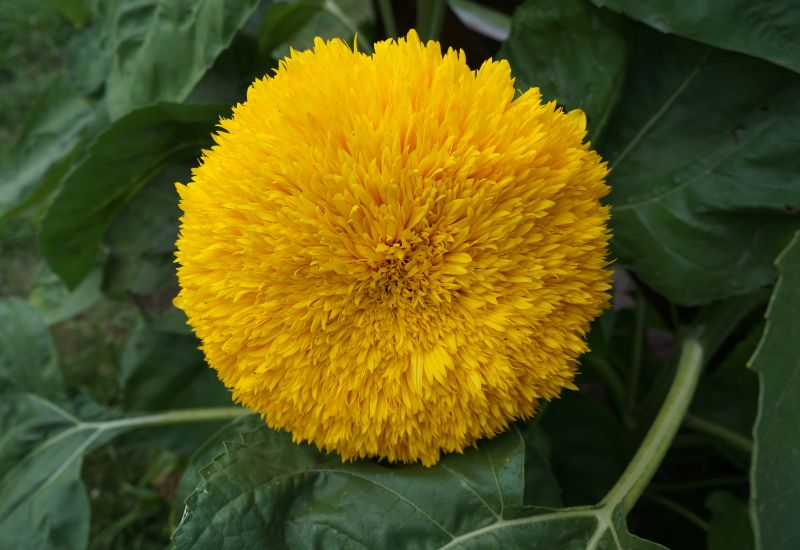
Teddy bear is arguably one of the sweetest dwarf varieties of sunflower… A cultivar of Helianthus annuus, it was given a very apt name indeed! Why? Well, just look at the blooms! They look fluffy, full, soft, like a cuddly toy, in fact.
Round and globular, super fully double, they resemble large double marigolds or dahlias, but if you look closely, you will find that the dense golden yellow petals that look like fur are actually thin and long…
It is literally impossible to count them, they are un the hundreds for sure for each head! These pompon blossoms are also quite showy, because if the plant itself is small, they are not! Each is about 5 inches across (12.5 cm), but it is their three dimensional quality that makes them unique.
In fact, they are at the same time welcoming, playful, childish and sculptural! Opening in mid summer and continuing till late in the season, and resting on lush foliage, they offer an amazing floral spectacle which has gained it the coveted Award of Garden Merit by the Royal Horticultural Society!
‘Little Bear’ is the dwarf sunflower variety you want to grow to bring light and structure to your sunny flower beds or low herbaceous borders, and it makes a spectacular cut flower as well!
8. ‘Sundance Kid’ Sunflower (Helinathus annuus ‘Sundance Kid’)
‘Sundance Kid’ is one of the earliest dwarf cultivars of Heliantus annuus, but also one of the most original. In fact, it only reaches about 2 feet in height (60 cm), but it has a very strong, almost unruly personality… And this is all due to the flower heads, which, despite coming on a miniature plant, range between 3 and 6 inches in diameter (7.5 to 15 cm), and they come at the tips of branched stems… But it is their appearance that makes them unique during the summer months, when they are in bloom…
The double blossoms have bright golden yellow ray petals, long and somewhat irregular in shape and habit. Move closer to the center and you will see smaller, fairly fluffy and very dense petaloids in shades of orange, copper, rust and reddish brown… But then, you will still see the disk in the very center, with its very dark, brownish, almost black color! It is a bit like a bull’s eye, and the leaves are broad, bright green and very strong looking indeed!
‘Sundance Kid’ is a dwarf annual sunflower variety that needs a very informal setting indeed, like a well litflower bed or border front in a traditional looking garden, or in a container on a sunny and friendly, playful terrace.
9. ‘Dwarf Sunspot’ Sunflower (Helianthus annuus ‘Dwarf Sunspot’)
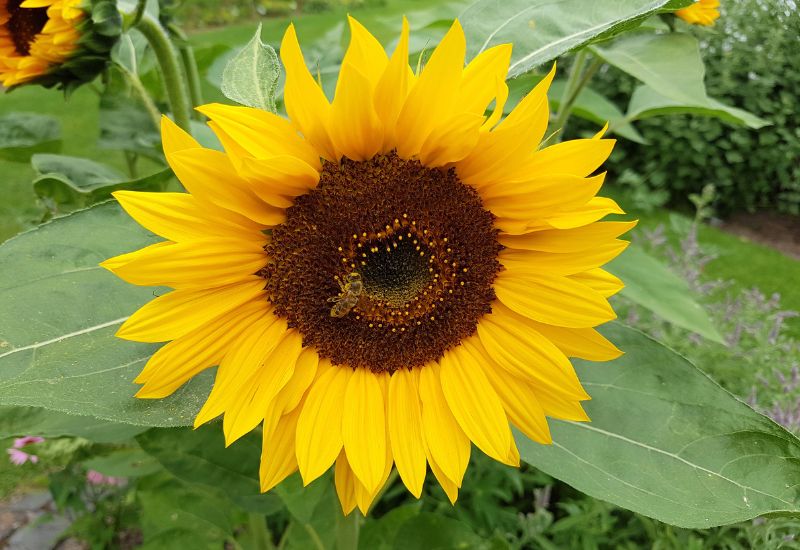
‘Dwarf Sunspot’ annual sunflower is a real miracle when it comes to size! Yes, because the sturdy, straight upward stems will only reach 3 feet tall (90 cm), but this dwarf variety retains the massive flower heads that you would normally find on her tall and famous sisters! In fact, the blooms are huge, 10 to 12 inches across (25 to 35 inches) and very traditional indeed!
This heirloom cultivar will blossom in summer, when the Sun is high and hot, and you will find all the beauty of our star reflected in your garden! The ray flowers are pointed, typically warm and vibrant golden yellow, and they are quite dense, forming a perfect crown! The inner disk is very large indeed, providing lots of florets for bees, butterflies and pollinators, and then as many seeds for little birds.
Its color goes from chestnut orangish to darker shades of chocolate and even mahogany, and this makes a perfect big eye in the middle of the floral display. The foliage is in the classical shape and texture, but, being compact, it is much more dense than in the giant varieties we all well know.
A favorite for cut flower, ‘Dwarf Sunspot’ is also great in containers or to provide massive and traditional looking summer blooms in flower beds and herbaceous borders in an informal garden or terrace, and no other cultivar can give you the same “countryside look” as it does!
10. ‘Double Dandy’ Sunflower (Helianthus annuus ‘Double Dandy’)
‘Double Dandy’ is one of the wildest looking dwarf varieties of annual sunflower you could ever grow in your garden. However, it is at the same time a very expressive and intense little plant… Let me explain it… Growing only to 2 feet in height (60 cm) it has good sized flower heads, about 4 to 5 inches across (10 to 12.5 cm), so they are showy.
But what strikes you is a combination of a mellow and lustrous palette with an unruly personality… The blooms have a set of very irregular, even twisting and pointed ray petals that seem to rebel to any law… And theseusually are on tonalities of pale and bright rose to magenta… Then, you will find a ring of petaloids that are quite fluffy but – again –randomly arranged, and they hit deeper notes on the purplish to burgundy range.
Finally, there is a fairly large central disk that takes up these shades and brings them to pitches of very dark purple, sometimes with violet overtones! The exact range changes, most likely due to sunlight and soil conditions, but the effect is always extraordinary and quite long indeed! On the other hands, the foliage keeps the sandpaper texture and broad shape that we are used to with this genus…
‘Double Dandy’ is the dwarf sunflower variety you want to cast the dice and see what happens in your flower beds and borders, because it breaks every rule, but it is also suitable for containers on sunny terraces. For sure, it can bring that sense of wild beauty to any composition.
11. Pacino Series Sunflower (Helianthus annuus ‘Pacino Series’)
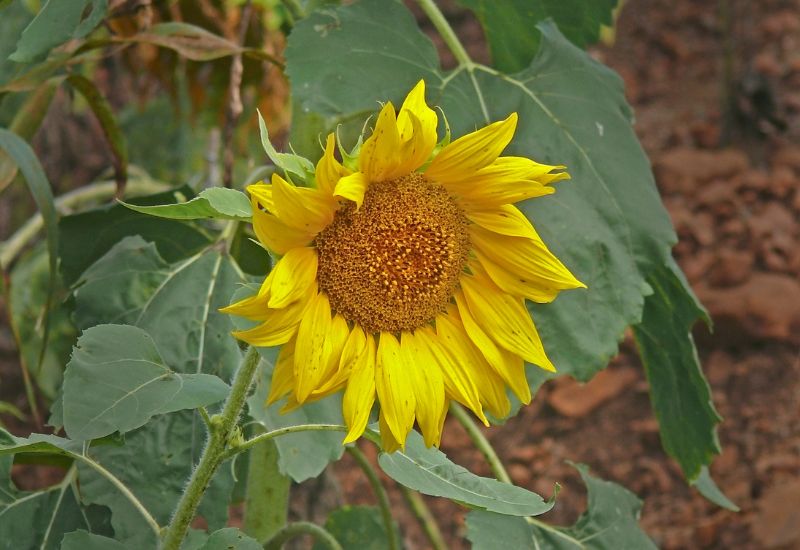
I would like to present some tiny twins now: the Pacino series of dwarf sunflower varieties. At are three at the moment on the market, but we might expect more in the future, and you can also buy the seeds as a mix… Growing to a maximum height of 2 feet (60 cm), whichever you choose you will still get pretty large flower heads, of approximately 5 inches across (12.5 cm) and for a long season, starting in June and ending in August.
Both have a balances shape, with long, elliptical and pointed day petals that form a crown around the disk, which is more or less of the same size as a single petal… This gives them a very harmonic personality, though there can be slight variations. Now, ‘Pacino Gold’ is the deeper and brighter of the two, offering you golden yellow, as you might expect, but also a a center of the same brilliant color.
His brother ‘Pacino Cola’ has the same color, but the florets in the middle are dark, on the brownish side. Finally, the sister of this family is called ‘Pacino Lemon’, with a brighter tonality that touches on the melon to crayola range, and of course, also lemon! And all will offer you the same and dense broad leaves along the stems, usually in a darkish green shade…
Of course, the main asset of the Pacino series of dwarf sunflowers is that you can get continuity in shape and delicate variation with the slightly different shades and combination… It is best to mix them up, as you may have guessed, in containers, or sunny borders – the choice is yours!
12. ‘Elf’ Sunflower (Helianthus annuus ‘Elf’)
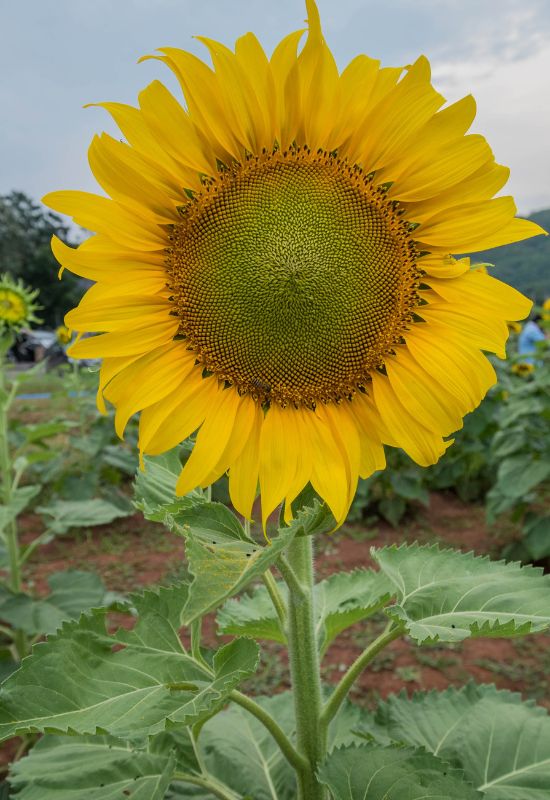
Finally, we end exactly where we began, with the shortest of all annual sunflower varieties, the diminutive ‘Elf’. In fact, as we said, it usually reaches only 16 inches in height at full maturity, which is 45 cm! Then again, you cannot expect massive blooms from to open on such small stems…
But still, this famous and much loved cultivar punches far above its weight, with flower head that touch the 4 inches in diameter (10 cm)! And they are quite attractive indeed… To start with, they are very balanced, with lots of long petals of the brightest golden yellow ever, which end in soft points at the tips.
They are quite dense around the inflorescence, and they also have a velvet like texture. The disk is about the same diameter as one of these is in length, so you have a harmonic 1/3, 1/3, 1,3 – very proportionate indeed! The center is darker, with warm shades of russet brown, which, however, will turn of the same color of the Sun itself as it matures.
What is more, it has very decorative leaves, which are broad and pointed, true, but they also tend to hang from the petioles pointing down. Apparently, it is also being made into a series, with subtle variations in tonalities between the little siblings.
‘Elf’ is a classic of dwarf annual sunflowers, and a favorite, for its small size but bright and colorful beauty. It will definitely fit into a container, and that is exactly where most people grow it. However, if you have a short bed that needs a burst of summer energy un summer – please be my guest!
Dwarf Sunflowers: Sort but Definitely Powerful!
You can find a few more dwarf varieties of sunflower, especially Helianthus annuus cultivars, and new ones are being bred all the time. However, most of the others are typically yellow, and they lack the personality and color range of the ones we have picked for you.
But you may have noticed that there is no clearly and fully red blossom among these… It may come soon, as it has for their taller sisters, but if in the meantime you want to “cheat” a bit… Mexican sunflower, Thitonia rotundifolia, does have a really tiny and scarlet to rust variety, called ‘Dwarf Fiesta del Sol’ with blossoms that would almost pass for real sunflowers’ but they are only 2 to 3 inches across (5.0 to 7.5 cm).

Written By
Amber Noyes
Amber Noyes was born and raised in a suburban California town, San Mateo. She holds a master’s degree in horticulture from the University of California as well as a BS in Biology from the University of San Francisco. With experience working on an organic farm, water conservation research, farmers’ markets, and plant nursery, she understands what makes plants thrive and how we can better understand the connection between microclimate and plant health. When she’s not on the land, Amber loves informing people of new ideas/things related to gardening, especially organic gardening, houseplants, and growing plants in a small space.

